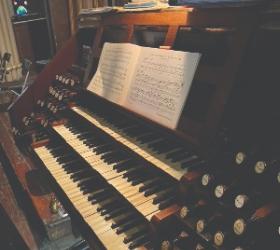
Schoenstein & Co., Organ Builders, San Francisco, California
Christ Church Episcopal,
Cambridge, Massachusetts
Schoenstein & Co., Benicia, California, were honored to be invited by one of the nation’s oldest and most famous parishes to propose a new organ, but the situation gave us pause: a very dry acoustic; a convoluted, L-shaped, deep, side chamber with poor tone openings; an historic church that could not be changed; and a hard act to follow—Aeolian-Skinner. (The organ to be replaced was the Aeolian-Skinner where E. Power Biggs had served as organist and which had been featured on Aeolian-Skinner’s recording, Studies in Organ Tone.)
The organ chamber is located in an addition off of the right side of the chancel with an extension tone chute over an entry hall. The chamber speaks not directly into the chancel, but into the side aisle. It was a tonal prison cell. Given the need for strict historical preservation of the building, there was no opportunity to create space for a large free-standing instrument or a new chamber.
The client’s request was for an Anglo-American symphonic-style organ to lead and support their modern Anglican services. Obviously, the architecture and the nature of the parish called for tone of nobility and refinement. Getting the sound out of the chamber, without it sounding harsh and forced, was the problem.
Certain design principles produce successful enchambered sounds. These include stoplists emphasizing bright, colorful diapason tones, strings and open flutes, with the main power of the ensemble dominated by chorus reeds rather than high mixtures. High pitches do not travel well around corners! An acoustically dry room reacts well to tone that is smooth, warm and rich. It helps to make up for the lack of resonance. Adequate wind pressure to provide intensity and projection of tone—not loudness—is vital. Pipe scaling and voicing must be bold. Finally, the organ must be laid out so that the sound gets out of the chamber through a large, fully opening shade front.
To ensure the success of the new organ, major renovation work was accomplished in the existing organ chamber and blower room. The largest and most important division in the organ, the Swell, was placed along the entire front section of the chamber, parallel to the front wall of the chancel. The main Swell windchests are placed in the full-height area of the chamber, with the double enclosed Inner Swell behind this. The double expression system of the Swell makes available a very broad dynamic range without changing stops. It is possible to add just a touch of reed tone (so little that the youngest soloist would not be overpowered), to hush the Flute Celestes to less than a whisper, and to harness the 32′ reed so that it may accompany even gentle string-toned stops; and yet its batteries enable the organist to achieve enormous power when necessary. Such tools for subtle beauty and precise control elevate the value of the organ in accompanying a service.
The Great and Choir divisions are located at floor level parallel to the side aisle and partially below the case impost level. All but two of the Great stops are enclosed, adding to the versatility and dynamic range of the organ.
The large wood Pedal pipes are stacked horizontally on the roof of the organ. This allows the manual divisions a more spacious layout and puts the bass pipes in a favorable position for a direct line of sight projection into the church.
Of the finished result, Stuart Forster, the director of music and organist, said: “It is necessary to document what a pleasure it is to play, and to listen to, this organ. The splendor of its individual voices (note the variety of flutes!), the cohesion and clarity of its choruses, the many effects and, of course, its colossal variety of expression in timbre and dynamics unite to create a musical instrument surpassing every hope of the committees, parishioners, donors, musicians, observers and visitors involved in this organ’s creation and service.”
—William Vaughan
GREAT
16′ Gamba
8′ First Open Diapason
8′ Second Open Diapason
8′ Harmonic Flute
8′ Gamba
8′ Gamba Celeste (TC)
8′ Bourdon
4′ Principal
4′ Bourdon
22⁄3′ Twelfth
2′ Fifteenth
13⁄5′ Seventeenth
11⁄3′ Mixture III–IV
8′ Trumpet (Choir)
8′ Clarinet (Choir)
8′ Tuba (Choir)
Chimes (Walker)
Cymbelstern
SWELL
16′ Lieblich Bourdon
8′ Open Diapason
8′ Stopped Diapason
8′ Echo Gamba
8′ Vox Angelica
4′ Gemshorn
4′ Harmonic Flute
2′ Flageolet
8′ Oboe
Tremulant
Stops Under Double Expression
8′ Flauto Dolce
8′ Flute Celeste (TC)
4′ Flauto Dolce
4′ Flute Celeste
2′ Mixture III–V
16′ Contra Fagotto
8′ Cornopean
4′ Clarion
8′ Vox Humana
CHOIR
16′ Dulciana
8′ Open Diapason (Great)
8′ Concert Flute
8′ Lieblich Gedeckt
8′ Dulciana
8′ Unda-Maris (TC)
4′ Fugara
4′ Forest Flute
22⁄3′ Nazard
2′ Harmonic Piccolo
13⁄5′ Tierce (TC)
8′ Trumpet
8′ English Horn
8′ Clarinet
Tremulant
Tremulant B Variable
8′ Tuba
8′ Tuben (III)
Harp (Walker)
Celesta (Walker)
PEDAL
32′ Sub Bass
16′ Open Wood
16′ Sub Bass
16′ Gamba (Great)
16′ Dulciana (Choir)
16′ Lieblich Gedeckt (Swell)
8′ Principal
8′ Flute (Great)
8′ Stopped Diapason (Swell)
8′ Dulciana (Choir)
4′ Fifteenth
4′ Flute (Great)
32′ Contra Fagotto (Swell)
16′ Ophicleide (Choir)
16′ Contra Fagotto (Swell)
8′ Tuba (Choir)
8′ Trumpet (Choir)
4′ Tuba (Choir)
4′ Trumpet (Choir)




